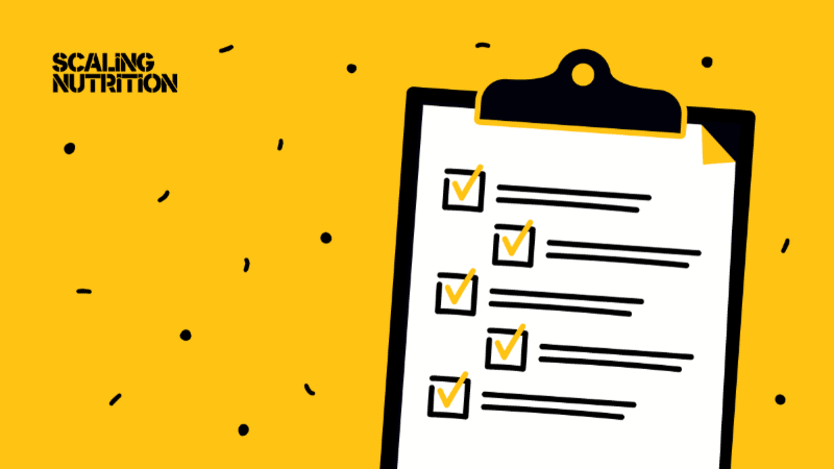
“Scalability” and “sustainability” have become buzzwords in global development circles. While both are important qualities that most projects aspire to, truly achieving these objectives is often far easier said than done — and requires careful thought and planning.
That’s why, when a U.K.-based team received a $2.5 million grant from the Eleanor Crook Foundation to work on a research project in Ethiopia — called C-MAMI, representing the phrase “community management of at-risk mothers and infants under 6 months” — they knew that they would need to build plans for scalability and sustainability into the very design of the project for it to be a success.
“It’s critical to have that sense of realism right from the start and to invest the time in identifying problems that could arise, rather than being surprised.”
— Marie McGrath, technical director, Emergency Nutrition NetworkThe project first began in 2008, when various NGOs working on humanitarian emergencies had noted that infants under the age of 6 months — generally thought to be at a lower risk of acute malnutrition due to the assumption that they are breastfed — were showing signs of the condition.
More on Scaling Nutrition:
► Opinion: Scaling up development impact — the opportunities and challenges
► Opinion: The tension in global nutrition that no one is talking about
► As development looks to increase scale, here are some of the key issues
Led by Marie McGrath, technical director of the charity Emergency Nutrition Network, and Marko Kerac, MSc program director and associate professor at the London School of Hygiene & Tropical Medicine’s Department of Population Health, the project began with a two-year research phase in collaboration with the University of London and Action Against Hunger. The aim was to better understand the burden of acute malnutrition in this specific age group, investigate how cases were managed, and identify what preexisting tools might be available to help inform stakeholders.
This research helped them discover that community-based options for the care of infants under 6 months of age were not available and were critically needed — unlike the case of older children, whose treatment had been revolutionized by community-based management of acute malnutrition.
But it wasn’t until nine years later, when the team received the ECF grant, that they had the opportunity to formally test all the theories and ideas they’d developed through their research process in a large-scale randomized clinical trial. From the moment they received the funding, they knew that sustainability and scalability would be critical to the overall success of the project, which started in August 2019 and is running for four years, with the main randomized controlled trial due to start in autumn of 2020.
“We knew we’d have to be very thoughtful about the design, because acute malnutrition in infants touches so many different parts of a health system,” Kerac said. “It can require skills — providing breastfeeding support or an issue of maternal mental health — so for this to be able to scale, we knew we’d have to involve these different professions and perspectives from the very beginning.”
Here are five tips on how to plan for scalability before a project even begins that McGrath and Kerac learned from their experience with C-MAMI.
1. Build longer-term goals into the design phase of a project through research and by asking tough questions
For the project to be successful, McGrath and Kerac’s team, co-researchers, and other stakeholders involved understood that considerations of scale and sustainability would need to be built into the project from the get-go.
To start, they knew they would need to invest in careful research to understand the true scale of the problem, what factors may be leading to acute malnutrition in infants under the age of 6 months, and what existing tools could be used to address this, according to McGrath. After the initial two-year research phase, McGrath and her colleagues knew that more information was still needed before they could arrive at potential solutions.
“We created a small, working special interest group to help define what the priority gaps we needed to address were and to see how to leverage the tools that already exist,” she said.
During the research and design phase, it’s also critical to ask questions aimed at fleshing out potential problems and concerns as early as possible, according to Kerac. This makes it far more likely that the intervention will end up being successful in a real-world scenario, taking into account the various challenges and constraints that front-line workers in low- and middle-income countries might face.
“It’s critical to have that sense of realism right from the start and to invest the time in identifying problems that could arise, rather than being surprised,” McGrath said. “We wanted a project that is good enough to scale, rather than something that is perfect on paper but isn’t practical in a real-world environment.”
2. Identify the best collaborators and work closely together to co-create project goals
McGrath and Kerac knew that the only way C-MAMI would be a success was if they had the right team — on the international, government, and local levels. That meant not only involving the right organizations — for example, the World Health Organization, ministries of health, universities, and local NGOs — but also identifying the individuals within each of the organizations that would best position the project to succeed.
“You may be working with an [entire] organization, but it’s the experience of the individuals that can make a difference,” Kerac said. “We often underestimate that.”
For C-MAMI, they worked closely with a professor at Jimma University in Ethiopia who, in addition to his academic credentials, had worked for years as a pediatrician in rural communities and recognized the types of challenges that front-line health workers often face.
“You want someone who understands what it is really like on the front line, in order to be equipped to have a sensible and practical scale policy,” McGrath said. “You also want individuals who can facilitate wider organizational links. Having the right team is critical.”
3. Focus on creating win-win situations
One of the best ways to ensure sustainability is to ensure that the various partners and stakeholders involved with the project are truly invested in its success.
“If a project is to be scaled, it has to be jointly owned, rather than being a product of one organization and set of investigators,” Kerac said. “It has to have a much larger ownership.”
When the C-MAMI team began to plan their research prioritization, for example, they made sure to involve a broad list of co-actors, rather than just their core team. They made sure to visit the research sites and work closely with stakeholders to collaboratively plan the research process and to flesh out any potential challenges before they could become problems.
According to Kerac, this commitment to truly listening, engaging partners, and being transparent with the process can be key to a project’s success.
“You want to have that true buy-in from the start,” he said. “By being open and having that sense of shared output with the larger group, you can maximize your chances of success.”
4. Recognize that scaling is an active process that requires constant learning
That might mean making use of framework guidelines, toolkits, checklists, or any other resources that already exist around how to make a project truly scalable. Management Science Institute, for example, offers many different tools that can be helpful for different sorts of development projects.
“You want to spend time having exposure to what others have already done, because there’s always the risk that you end up reinventing something,” Kerac said. “That’s why it’s always worth it to spend a bit more time with the formal materials that are already there.”
5. Make sure that the project and team are flexible and willing to adapt to feedback throughout the project’s lifetime
Above all, it is critical to maintain a sense of openness and flexibility throughout the entire planning process, according to Kerac. “You need to be open. So rather than just, ‘How do we forward our agenda and our projects?’ you want to be on the lookout for how to be helpful to others,” he said. “This [approach] helps to foster an atmosphere of greater openness and make the project more relevant to a wider constituency — and all that helps a project be more scalable.”
Update, Dec. 11, 2019: This article has been updated to clarify the importance of community-based care for infants under 6 months.
Update, Dec. 17, 2019: This article has been updated to more accurately reflect Marko Kerac’s roles at the LSHTM Department of Population Health and the timeline of the team’s project.
Take a closer look at what it takes to achieve scale in the nutrition sector.









